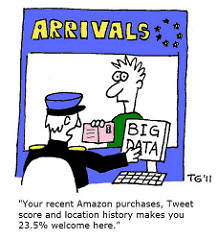Big data is not the answer, no matter whether you’re a big business or small. Big ideas from big business is what can create an impact on your bottom line. Unfortunately, one doesn’t always lead directly to the other.
Data on its own isn’t necessarily worth a whole lot. All the proof you need is in the fire hose of data that tools like Google Analytics provide. Here are some ideas for generating your own big ideas from the big data at your fingertips.

Cartoon by Thierry Gregorius.
Patterns in Marketing Data
Rarely is a snapshot as accurate or as informative as a moving image. That holds for data, as well. You’re much more likely to find insights in patterns that you can detect over time.
Searching your data for patterns that emerge over time can help you improve marketing performance by separating the signal from the noise, as they say. In other words you’ll be able to see what is changing over time for your business, and what are one-time outliers that can be ignored.
Some of this is pretty basic stuff – ramping up marketing and advertising in advance of your busiest selling season, for example. Other patterns can be less obvious, like the cadence of visits to your website for your best leads. Finding that information can take some digging and connecting different kinds of data or even different data sets.
Connections Across Marketing Data
And when we think about connections, they don’t only have to be patterns that emerge over time. For example, the connection between your most qualified leads and the page on which they enter your site can tell you about the kind of content they’re most interested in and the prospects you want to engage with most urgently.
That same data point might also allow you to make connections between your best prospects and your most productive promotional channels. How these prospects get to that popular page – email marketing, social media, or some other method – might provide another layer of insight, as well.
Borrowed Marketing Data
Not all the data you use to power your Big Idea Engine need to be your own. You can use the data that others are aggregating.
Sometimes this takes the form of industry benchmark data. If you’re thoughtful in how you make the comparisons, you can measure your efforts and results against those of similar companies. There can be danger in this approach in that you don’t necessarily know how similar the firms in the data set are to yours. And you don’t know how accurately the aggregated data has been tallied and interpreted, so proceed with caution. Still, the low cost can make this a very attractive approach, particularly when you’re starting out and may not have data of your own to read.
In the end, the insights and ideas you gain from the data your digital marketing produces are a result of equal measures of hard work and inspiration. The more time you spend shuffling the cards, the likely you are to see combinations that lead you to insights that produce positive results.